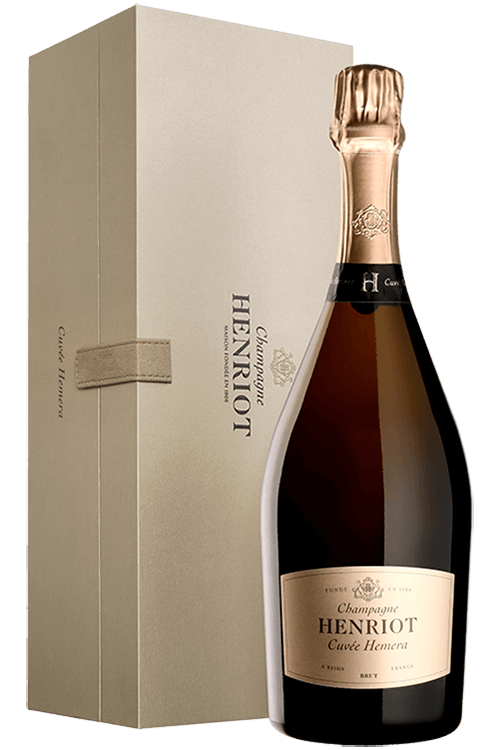

The composition of the wine reads like a straight-from-central-casting portrayal of what we imagine a historic Champagne house’s lineage to be. As a vintage Champagne that has just become available on the market this month, at $185 SRP, it’s here to make a statement. There isn’t much middle ground when it comes to Champagne Henriot’s Cuvée Hemera 2006. It is an age-defying beauty that is the best possible testament to Henriot quality.Vintage Champagne That Reads Like A Screenplay: 2006 Champagne Henriot Cuvée Hemera

In addition to the very fine 19, there are 48 magnums of the majestic 1959 Cuvée des Enchanteleurs (Henriot’s prestige cuvée, since renamed Cuvée Hemera) in magnum. Fortunately, and as if to prove the point, Henriot recently brought to market its Mémoires collection of three old, recently disgorged vintages from the family cellars. The result is a palate-pleasing, attractively toasty and age-complexed non-vintage wine.īut it is Henriot’s older, vintage cuvées that will truly excite any wine lover. Produced only in magnums, 1,000 decadently rich and flavourful examples are now released each year.Ī small amount of the Cuve 38 blend still makes its way into Henriot’s non-vintage Brut Souverain, which contains at least one wine from each of the 25 villages from which the house sources, along with 30% reserve wines for an extra degree of richness and complexity. Eventually, he came up with the idea of bottling this special blend, and in 2007, a blend of 17 harvests from the villages of Le Mesnil-sur-Oger, Chouilly, Avize and Oger gave birth to Cuve 38, which received its inaugural release in 2014. The variety was very much cherished by Joseph Henriot, who started blending the best into one tank, number 38, which became a reserve wine to be added to Henriot’s non-vintage Champagnes to enforce the house DNA. Time is a friend here, and we really take time in crafting our Champagnes.’Ĭhardonnay dominating at Henriot is a trait that can be traced back to the 1880 marriage of Paul Henriot to Marie Marguet, who brought with her great Chardonnay plots on the Côte des Blancs. ‘Our style is a combination of freshness and generosity. ‘Our house represents Champagne classicism,’ she says, confidently. She is not, though, about to rip up the Henriot rule book. For Henriot, the engaging Tétienne brings a sense of energy and focus that has been missing in previous years. This is, at last, the era of the female chef de cave, with the likes of Krug, Duval-Leroy, Joseph Perrier and Ayala all showcasing female figureheads. Today, the Henriot spotlight is very much focused on Tétienne. In 2020, de Larouzière recruited Alice Tétienne – one of Champagne’s growing crop of young, female cellar masters – from Krug, where she had been responsible for grower relations and was a member of the tasting committee. ‘But we realise now that we are also a brand, and we need to shine.’ ‘It has never been in the family spirit to put ourselves to the fore,’ de Larouzière continues. There were, though, other reasons why the house disappeared from view. ‘The international markets especially were ignored,’ he opines.
Henriot hemera full#
‘And then, of course, at Veuve Clicquot the stakes were very high, so the job demanded his full energy.’ De Larouzière goes on to make a comparison with Ruinart, a house with which he says Henriot was on a par in the 1980s but which kept on rising while Henriot stood still – at least from a communications point of view. ‘From 1976 onwards, Joseph had Charles Heidsieck’s problems to solve,’ de Larouzière says. It’s fair to say that he had his hands full. And even when, in 1994, Joseph Henriot bought the brand back – minus the vineyards – he immediately went about expanding into Burgundy, via the purchase of such notable wineries as Bouchard Père & Fils and William Fèvre. It was a role so consuming that the family brand received less of his attention. Immediately after that, he exchanged Champagne Henriot’s magnificent estate of 125ha for 11% of Veuve Clicquot stock and a role with the house, which morphed into a post on the LVMH board. First, in 1976, there was the purchase of Charles Heidsieck, which he sold a decade later to Remy Martin. Much of that business, however, related to other Champagne brands. Joseph Henriot, the house’s late 20th-century powerhouse, was a busy man.


 0 kommentar(er)
0 kommentar(er)
